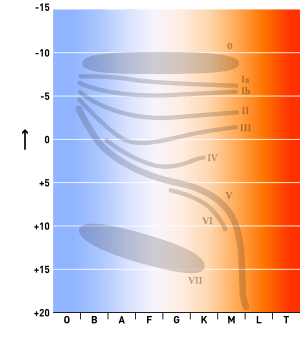G-type main-sequence star facts for kids
A GV star is a type of star found on the main sequence. You might also hear it called a yellow dwarf. These stars have a special classification: spectral type G and luminosity class V. This classification helps scientists understand their properties.
The name "yellow dwarf" can be a bit confusing. G-type stars actually range in color. Brighter ones, like our Sun, look white. Less massive G-type stars might have a very slight yellow tint. You can see how star colors are classified by looking at a spectral classification chart.
GV stars are not very big. They are about 0.8 to 1.0 times the size of our Sun. Their surface temperature is quite hot, between 5,300 and 6,000 Kelvin. Like all main-sequence stars, GV stars create energy. They do this by turning hydrogen into helium deep inside their core. This process is called nuclear fusion.
Our Sun: A Perfect GV Star Example
Our own Sun is the most famous GV star. It's also the easiest one for us to see! Every second, the Sun changes a huge amount of hydrogen into helium. It combines about 600 million tons of hydrogen. This process turns about 4 million tons of matter into pure energy.
When we look at the Sun from Earth, it often looks yellow. This is because of something called Rayleigh scattering in our atmosphere. Without Earth's atmosphere, the Sun would actually appear white. Even though they are called "dwarfs," yellow dwarfs like the Sun are very bright. They are brighter than 90% of all the stars in the Milky Way galaxy. Most stars in our galaxy are smaller, like orange dwarfs, red dwarfs, and white dwarfs.
Other examples of GV stars include Alpha Centauri A, Tau Ceti, and 51 Pegasi.
The Life of a GV Star
A GV star shines brightly for a very long time. It fuses hydrogen for about 10 billion years. This is a huge amount of time!
Once a GV star uses up its hydrogen fuel, big changes happen. The star will grow much larger than before. It will become a red giant, like the star Aldebaran.
Eventually, the red giant will start to lose its outer layers of gas. These layers will float away into space, forming a beautiful cloud called a planetary nebula. What's left behind is the star's inner part, or core. This core will cool down and shrink. It becomes a small, very dense star called a white dwarf.
Other Stars to Explore
See also
 In Spanish: Estrella de tipo-G de la secuencia principal para niños
In Spanish: Estrella de tipo-G de la secuencia principal para niños



